15 Foods That Naturally Lower Blood Pressure

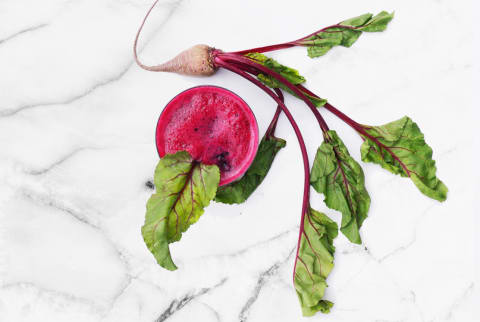
High blood pressure is one of those conditions that can quietly and slowly damage your body. For starters, uncontrolled blood pressure can lead to stroke, narrowing of arteries, heart failure, kidney problems, damage to eye vessels, dementia, and other serious conditions. That's the bad news. The good news is that what you eat can significantly help you reduce your blood pressure, especially if it's already elevated or in the borderline range.
Here are the best 15 foods that you can eat to naturally lower your blood pressure and safeguard your long-term health:
1. Swiss chard, spinach, arugula, turnip greens, beet greens, collard greens, and other leafy greens
What do all these foods have in common? Potassium. This nutrient reduces blood pressure by balancing electrolytes in the body and helping the kidneys get rid of excess sodium. Aiming for 4,700 mg of potassium daily from foods like leafy greens can help you do that! Bananas tend to get all the fame when it comes to potassium, but a cup of cooked Swiss chard contains 960 mg potassium, and a cup of cooked spinach contains 839 mg potassium, while one banana contains only about half of that (422 mg). Since they are lower in carbohydrates and calories, leafy greens may fit better into your overall health goals.
Magnesium is another mineral that helps lower blood pressure by dilating blood vessels. A meta-analysis1 found that, on average, 400 mg of magnesium per day lowers diastolic blood pressure by 2.2 points. A cup of cooked spinach contains 157 mg of magnesium.
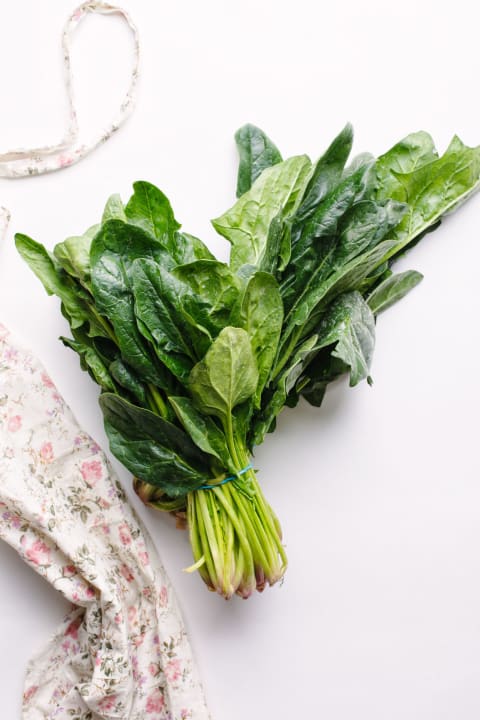
Spinach and arugula also contain nitrate, which dilates arteries and reduces blood pressure. Don't confuse nitrate, found naturally in spinach, arugula, celery, and other vegetables, with nitrites found in cured and aged meats. Healthy women who ate nitrate-rich2 vegetables for one week reduced systolic blood pressure. Another study found that a Japanese diet3 high in nitrate reduced diastolic blood pressure by 4.5 points compared to a diet low in nitrates.
2. Acorn squash, yams, sweet potatoes, and other winter squashes
One baked potato contains 926 g of potassium, and a cup of acorn squash contains 896 g of potassium. Sweet potatoes and butternut squash are runners-up. These vegetables are starchy, so stick to about one cup a day and use them to replace other high-carbohydrate foods like processed grains, sweets, or pastries. Roast acorn squash and mix with collard greens for a nice fall side dish. Make butternut squash soup. A baked white or sweet potato can fit into a healthy diet—as long as your plate has other nonstarchy veggies.
3. Berries

Berries are rich in polyphenols and vitamin C, which can help reduce inflammation in arteries. Two servings of berries a day for eight weeks reduced systolic and diastolic blood pressure in people4 who had mild hypertension. Those who had higher blood pressure levels at the beginning of the study showed the most reductions. Incorporate a variety of berries in your diet—in smoothies, snacks, or salads. Frozen berries are earth's natural ice pops!
4. Beans and lentils
Beans and lentils are excellent sources of potassium and magnesium. Cooked lentils have 731 g of potassium per cup and a cup of cooked lima, white, pinto, or kidney beans has between 700 to 950 g potassium. Beans also contain magnesium, with as much as 120 g of magnesium packed into just one cup of cooked black beans.
5. Oats
It might come as a surprise, but oats are also a great food to eat if you want to be mindful of your blood pressure. This is thanks to a special fiber in oats, called beta-glucan, which helps reduce blood pressure. A study5 found that consuming oat beta-glucan daily lowered blood pressure in obese men and women with elevated blood pressure at baseline. A different small study6 found that 5.5 g of beta-glucan daily from oats for six weeks reduced systolic and diastolic blood pressure by 7.5 and 5.5 points in people who had mild or borderline hypertension.
Unfortunately, the amount of beta-glucan in oats will vary and isn't listed on nutrition labels. A rule of thumb to follow is that higher fiber content in general means more beta-glucan. Rolled oats contain 3.3 grams of fiber per ⅓ cup while the same amount of oat bran packs 6 grams. Just be aware that oat fiber may increase bowel movement frequency or cause stomach upset as it gets fermented by your gut bacteria. If your diet is low in fiber, start gradually. If it causes severe diarrhea or stomach pain that won't go away with slow introduction, consult with a dietitian who has experience in digestive health to see if oats are a good fit for you.
6. Beetroot juice
If you're a fan of beets, you'll be happy to learn that beetroot contains nitrate, which dilates vessels and reduces blood pressure, in addition to potassium and polyphenols. One study7 found that a little less than 5 ounces of beetroot juice reduced systolic and diastolic blood pressure by 7.9 and 5.7 points just three hours after drinking it. A meta-analysis8 also found that beet juice reduced systolic and diastolic blood pressure, especially when consumed for 14 days or more.
Roasted beets as a side dish or adding beats to salads is a healthy and beautiful addition to everyday meals. However, the research on blood pressure is done with beet juice. If you want to replicate the benefit at home, pull the juicer out and add some fresh beet juice to your daily routine!
7. Salmon
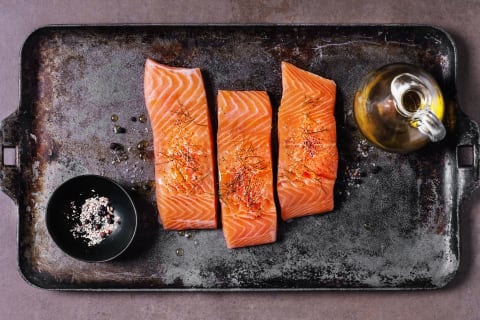
The health benefits of salmon seem to be never-ending—and blood pressure is no different. In one study, researchers found9 that eating 150 mg (5 ounces) of salmon containing 2.1 g of omega-3 fatty acids three times a week reduced diastolic blood pressure by 2 points. Fish oil capsules that contained 1.3 g of omega-3s had a similar effect. While cod had no effect on blood pressure in that study, it packs—along with tuna, halibut, and scallops—an excellent amount of potassium, making it a great addition to a healthy diet.
8. Olive oil
Olive oil is another food that has endless health benefits. One study showed that a daily intake10 of 1 ounce of polyphenols from olive oil for two months reduced systolic and diastolic blood pressure by 7.91 and 6.65 points. Improvement was more significant in people who had higher blood pressure levels to start with.

Olive oil products have a wide range of polyphenol levels11, so keep in mind that the fresher and more bitter and pungent the olive oil, the more polyphenols in has. Obtain olive oil from high-quality sources and eat it raw as much as possible. Drizzle over salads and on vegetables after you finish cooking them. In the study, polyphenol-depleted olive oil didn't show lower blood pressure.
9. Pistachio
If you're willing to put in the work of de-shelling pistachios one by one, your blood pressure will thank you. Research has shown that people with high cholesterol12 who followed three diets for four weeks each: a control low-fat diet, a diet with one serving of pistachios a day (10 percent of calories), or a diet with two servings of pistachios a day (20 percent of calories). Eating one serving of pistachios reduced systolic blood pressure the most by 4.8 points. That's just to show that more isn't always better!
All you cashew and almond butter fans might be wondering: What about other nuts? Mixed nuts13 lowered blood pressure but only in people without type 2 diabetes—and pistachios were still the most effective.
10. Flaxseeds
If possible, buy whole flaxseed and grind as much as you need every few days. Add to your oatmeal or smoothie, or use instead of white flour for pancakes, muffins, or breading. Flaxseed oil may not lower systolic blood pressure, but diastolic blood pressure may improve15 with both the oil and the meal.
Other seeds like pumpkin and chia seeds may also help lower blood pressure as they are excellent magnesium sources.
11. Dairy foods
Dairy isn't for everyone, but if you can tolerate it, you should know that a study16 on over 2,500 people—with normal blood pressure who were tracked for 14.6 years—showed that those who ate three or more servings of dairy per day or week compared to fewer than one serving, had slower increases in blood pressure. In other words, dairy consumption delayed hypertension but didn't completely prevent it.
A meta-analysis17 also showed that low-fat dairy and milk reduced the risk of hypertension while cheese, yogurt, fermented dairy, or full-fat milk had no effects. A later systematic18 review agreed, but the authors concluded that it is not clear whether low-fat dairy was more beneficial than regular-fat dairy when it comes to blood pressure.
If you can tolerate dairy, enjoy it daily or weekly as it may help reduce your risk for developing high blood pressure. If you can't tolerate it due to food sensitivities, allergies, digestive discomforts, or autoimmune issues, don't stress. You can get benefits from the other foods on this list.
12. Pomegranate juice
Pomegranate juice is more than just a beautiful color, with one study showing that men and women who drank 11 ounces of pomegranate juice19 daily for four weeks reduced systolic and diastolic blood pressure by 3.14 and 3.33 points. Another study20 found that drinking 5 ounces reduced systolic blood pressure by 7 percent and diastolic blood pressure by 6 percent when measured six hours later.

But do you really need 11 ounces to get the benefit? A meta-analysis21 found that any amount of pomegranate juice (higher or lower than 8 ounces) and for any duration (longer or shorter than 12 weeks) reduced systolic blood pressure. However, diastolic blood pressure reduction was significant only with more than 8 ounces a day. Start with a small amount, about 4 to 8 ounces, if you're trying to manage your sugar intake. It may be all that you need to benefit from this super fruit!
13. Garlic
Garlic is one of those low-key superfoods we tend to underestimate. But several studies22 found that taking garlic powders and extracts for one to three months can lower systolic and diastolic blood pressure in people with high or normal blood pressure. However, it is difficult to extrapolate the exact benefit of garlic as a food from studies that looked at concentrated doses. Allicin is the active ingredient in garlic and makes up only 1 percent of its weight.
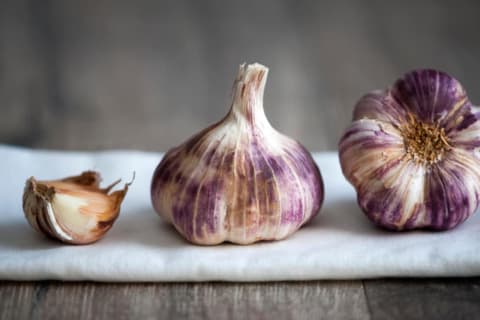
Fresh garlic has more allicin than cooked, so eat few raw garlic cloves daily to see significant changes in blood pressure. Add minced or chopped garlic to salad dressings or dips. Raw garlic goes well with tahini and lemon, while parsley or cilantro help neutralize garlic breath! Don't take garlic supplements without consulting your dietitian or doctor as they may cause heartburn, burping, upset stomach, or too much blood thinning.
14. Dark chocolate
Good news for all the chocolate lovers out there! Polyphenol-rich chocolate23 can lower blood pressure by 2 points on average, especially if your blood pressure is already elevated. In one study24, people who had slightly elevated blood pressure reduced systolic and diastolic levels by 2.9 and 1.9 points after eating 0.2 ounces of dark chocolate daily for 18 weeks. However, another study25 on middle-aged overweight women found that 22 g of cocoa daily had no effect on blood pressure (they found other cardiovascular benefits from chocolate, though!
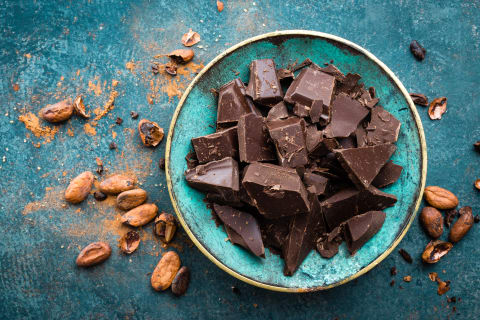
The verdict? Don't get carried away! A small amount of dark chocolate may help as part of a healthy, vegetable-rich diet. But large portions of sweetened, milk, or white chocolate may not be as helpful as we all wish they could be!
15. Hibiscus tea
The dried flowers and stems of the hibiscus plant have been used throughout history for blood pressure and other ailments. In patients who were pre-hypertensive or had mild hypertension, drinking26 three cups of hibiscus tea daily for six weeks reduced systolic blood pressure. Reductions were most significant in people who started with higher levels.
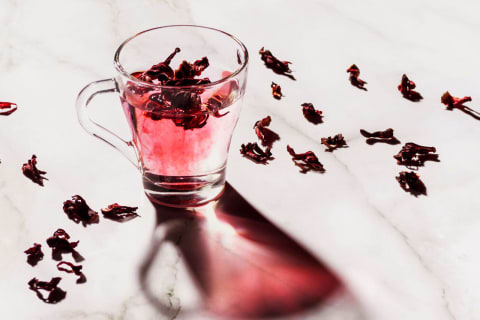
Enjoy hibiscus tea warm or cold. It has a sour taste, so resist the temptation to add too much sugar. Keep in mind that it's not safe during pregnancy as it can affect hormone levels and induce early labor. If you're not pregnant but have hormone fluctuations, start slowly and monitor how your body reacts.

Nour Zibdeh is a functional and integrative dietitian and nutritionist, author, and speaker. She received a B.S. in Human Nutrition from Virginia Tech and an M.S. in Health Sciences from James Madison University. Zibdeh completed an internship program with Virginia Tech and is nationally registered as Registered Dietitian Nutritionist (RDN) with the commision on dietetic registration. She is a Certified LEAP Therapist (CLT) with special training on food sensitivity, and has completed several integrative and functional nutrition courses and trainings. She helps her patients with digestive disorders, thyroid and hormone imbalances, autoimmune diseases, food sensitivities, chronic fatigue, migraines and headaches, fibromyalgia and chronic pain uncover the root causes and teaches them what and how to eat to thrive. Zibdeh is the author of The Complete Acid Reflux Diet Plan: Easy Meal Plans and Recipes to Heal GERD and LRP and The Detox Way: Everyday Recipes to Feel Energized, Focused, and Physically and Mentally Empowered.
26 Sources
- https://www.ncbi.nlm.nih.gov/pubmed/22318649?dopt=Abstract
- https://www.ncbi.nlm.nih.gov/pubmed/25683748
- https://www.ncbi.nlm.nih.gov/pubmed/19887114
- https://www.ncbi.nlm.nih.gov/pubmed/18258621
- https://www.ncbi.nlm.nih.gov/pubmed/17151592
- https://www.ncbi.nlm.nih.gov/pubmed/11978262
- https://www.ncbi.nlm.nih.gov/pmc/articles/PMC5707742/
- https://www.ncbi.nlm.nih.gov/pubmed/29141968
- https://www.ncbi.nlm.nih.gov/pubmed/19487105
- https://www.ncbi.nlm.nih.gov/pubmed/22914255
- https://www.ncbi.nlm.nih.gov/pubmed/23070730
- https://www.ncbi.nlm.nih.gov/pmc/articles/PMC3862178/
- https://www.ncbi.nlm.nih.gov/pubmed/25809855
- https://www.ncbi.nlm.nih.gov/pubmed/24126178
- https://www.ncbi.nlm.nih.gov/pubmed/26071633
- https://www.ncbi.nlm.nih.gov/pubmed/26395861
- https://www.ncbi.nlm.nih.gov/pubmed/22987924
- https://www.ncbi.nlm.nih.gov/pmc/articles/PMC5105032/#b12
- https://www.ncbi.nlm.nih.gov/pubmed/22648092
- https://www.ncbi.nlm.nih.gov/pubmed/24575134
- https://www.ncbi.nlm.nih.gov/pubmed/27888156
- https://www.ncbi.nlm.nih.gov/pubmed/26764326
- https://www.ncbi.nlm.nih.gov/pubmed/28439881
- https://www.ncbi.nlm.nih.gov/pubmed/17609490
- https://www.ncbi.nlm.nih.gov/pubmed/24274771
- https://www.ncbi.nlm.nih.gov/pubmed/20018807